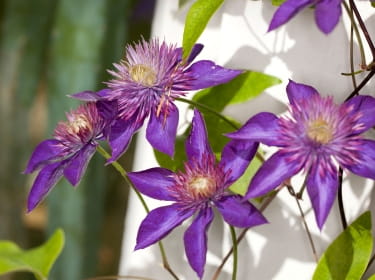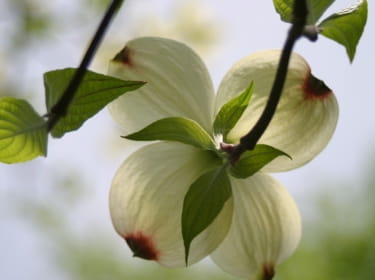Skin Problems from Outdoor Plants

The Bottom Line
Mechanical injury, chemical irritation, allergic reactions, and light-sensitivity are all possible effects of exposure to certain plants—not just poison ivy.

The Full Story
Poison ivy gets all the press, but other outdoor plants can pose problems, too. Mechanical injury, chemical irritation, allergic reactions, and light-sensitivity are all possible effects of exposure to certain plants. People who garden and enjoy outdoor recreation should take some precautions.
Injury to the skin is common from exposure to thorns, cactus spines, and spiny or sharp leaves. And, stinging nettles really do sting! Punctures from rose thorns are well known. There are thorns on the ornamental shrub barberry. The tips of holly leaves are sharp enough to puncture the skin. Spines from cacti are strong enough to do the same. Even small, nearly invisible "hairs" on cacti can be strong enough to puncture skin. Fibers on tulip and daffodil bulbs can cause injury, as can nearly invisible "hairs" on dogwood leaves. Sometimes, the puncture itself is the only injury. In other cases, histamine is released; the victim has a puncture wound plus local itching. And, any break in the skin can lead to infection.
Many plants can cause chemical irritation, including some ornamental plants. Anemones, daisies, clematis, snow-on-the-mountain (a Euphorbia), and hellebore are among the plants which can cause skin rashes and irritation if handled. Chili peppers, whether ornamental or culinary, can cause intense burning if they are handled without gloves.
In addition to poison ivy, English ivy (Hedera helix and related species) can cause an allergic skin reaction. Even though the two plants aren't related, allergic reactions have been reported in gardeners after trimming English ivy and in children who played with English ivy or climbed trees covered with it. Itching, rashes, and weepy blisters can occur.
Some plants can lead to injury if sap or juice drips onto skin and that skin is then exposed to sunlight. A red rash and possibly blisters occur. As the skin heals, the affected areas may become much darker than usual; these darkened areas may take weeks or months to fade. Garden plants that can cause this reaction include carrots, parsnips, dill, fennel, and celery. Citrus juice can cause the same effect; if you spill a drink with orange, lemon, or lime juice on your bare skin, be sure to wash it off quickly.
Preventing these itchy, blistery, uncomfortable skin reactions involves some common-sense steps.
- When gardening or doing yard work, cover as much skin as you can. Wearing gardening gloves can prevent many plant materials from piercing your skin. Long pants and sleeves can prevent "weed whacker" dermatitis – the rashes that occur when pieces of grass, weeds, poison ivy, and other plant materials are thrown back forcefully onto skin.
- Avoid touching your face and eyes when working with outdoor plants.
- If you know you have plant material, juices, or sap on your skin, wash quickly with plenty of running water.
Here's what to do if you are injured by some type of plant material.
- Wash the area thoroughly with plenty of running water and soap.
- If your tetanus immunization is more than five years old, contact your health care provider; you may need a booster.
- Use over-the-counter steroid cream if needed to control itching and irritation. Over-the-counter antihistamines, such as diphenhydramine, may help, too. If these don't control your symptoms, or if they seem to get worse, contact your health provider. You may need prescription-strength medicines.
- Observe the area for such signs of infection as red streaks around the area, swelling, pus, or a lot of discharge. If this happens, see your health care provider. If you have questions about plants or plant poisons, call Poison Control at any time: 1-800-222-1222.
Swallowed a possibly poisonous plant? Use the webPOISONCONTROL® online tool or call Poison Control at 1-800-222-1222. Expert help is available 24 hours a day, online or by phone.
Rose Ann Gould Soloway, RN, BSN, MSEd, DABAT emerita
Clinical Toxicologist
Poisoned?
Call 1-800-222-1222 or
Prevention Tips
- When gardening or doing yard work, cover as much skin as you can.
- Avoid touching your face and eyes when working with outdoor plants.
- If you have plant material, juices, or sap on your skin, wash quickly with plenty of running water.
This Really Happened
An 11-year-old boy and his friend were clearing weeds near his home. The weeds were later identified as cow parsnip (Heracleum lanatum). The next day, he had pain, redness, and blisters on both arms. (The other children had some redness on their arms.) Within three days, the blisters became very large, painful, and full of fluid. Treatment involved removing skin over the blisters and treating the areas like burns, with wound care and physical therapy. The rash improved, but very slowly. Several months later, the areas remained darker than his normal skin color.
Reference: McCue AK. Clinical images: a mystery. Wilderness and Environmental Medicine. 2007;18:156-159.
For More Information
The "Don't Touch Me Plants" (Purdue University)
Poisonous and non-poisonous plants: An illustrated list
References
Sasseville D. Clinical patterns of phytodermatitis. Derm Clin. 2009;27:299-308.
Poisoned?
Call 1-800-222-1222 or
Prevention Tips
- When gardening or doing yard work, cover as much skin as you can.
- Avoid touching your face and eyes when working with outdoor plants.
- If you have plant material, juices, or sap on your skin, wash quickly with plenty of running water.
This Really Happened
An 11-year-old boy and his friend were clearing weeds near his home. The weeds were later identified as cow parsnip (Heracleum lanatum). The next day, he had pain, redness, and blisters on both arms. (The other children had some redness on their arms.) Within three days, the blisters became very large, painful, and full of fluid. Treatment involved removing skin over the blisters and treating the areas like burns, with wound care and physical therapy. The rash improved, but very slowly. Several months later, the areas remained darker than his normal skin color.
Reference: McCue AK. Clinical images: a mystery. Wilderness and Environmental Medicine. 2007;18:156-159.
